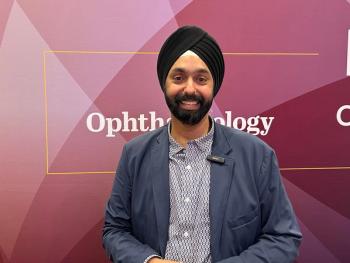
- Ophthalmology Times: April 15, 2021
- Volume 46
- Issue 7
Focus on molecular mechanisms underlying cataract development
Several hundred genes are associated with congenital forms.
Special to Ophthalmology Times®
Cataracts are the most common cause of blindness worldwide1 and a very significant cause of visual impairment in infants and children.
Congenital cataracts are seen in 10 to 60/100,000 births in the United Kingdom and in 50 to 150/100,000 births in developing countries.2
Identifying the genetic variants causing congenital cataracts has not only improved our understanding of the pathogenesis of infantile cataracts, the most frequent treatable cause of childhood blindness, but also their more common counterpart, adult-onset cataracts.
Lens development
The ocular lens provides a unique model for understanding the inductive interaction of various embryonic tissues, as well as cell differentiation, signaling, proliferation, physiology, biochemistry, longevity, and organelle degradation.
The structure is surrounded by a thick capsule and filled with elongated lens epithelial cells (LECs) that have differentiated into lens fiber cells.
The lens is the only organ that continually evolves and increases in size without replacing any cell in its system.
It performs its role to refract light onto the retina until mutation or the effects of aging, the environment, or intrauterine infections compromise its transparency and optical function.
Such insults cause changes to the biomolecules and trigger homeostatic imbalance in the lens, leading to protein aggregation and cataracts, thus increasing light scatter to affect refraction and cause loss of vision.
Lens development is a result of a series of inductive events during eye morphogenesis. The eye begins to develop during gastrulation at the beginning of week 4 (day 22, Carnegie stage 9).
A single eye field (eye primordium) arises in the middle of the anterior neural plate (diencephalon region of the developing brain), which separates into 2 optic vesicles and induces the overlying surface ectoderm to form the lens placode (lens primordium) by day 28 (Carnegie stages 12-13).
During this stage, a series of inductive interactions begin to shape the eye, driven by signaling molecules such as bone morphogenetic proteins and fibroblastic growth factor 2, and by eye field transcription factors including PAX6, RAX, SIX3, and LHX2.3-5
The lens placode invaginates to form the cup-shaped lens pit, which makes a complete circle of cells and separates from the surface ectoderm to develop into the lens vesicle.
The portion of the optic vesicle that faced the lens placode gives rise to the retina. The retina, in turn, provides oxygen and inductive signals that regulate the growth and apical-posterior axis of the lens.
This tissue integration continues to enable the functional optimization of eye function with the establishment of emmetropia.
In the early optic cup stage, the lens vesicle releases signals that induce the overlying surface ectoderm to differentiate into the corneal epithelium.
After the lens vesicle has closed (weeks 4-5; Carnegie stage 15), secondary fiber cells add to the growing lens as the fetal nucleus starts to form in weeks 6 to 7 (Carnegie stages 16-19), derived from the epithelial cells located at the equator of the developing lens.
Around week 8 (Carnegie stage 20), the Y-shaped suture appears at the anterior and posterior poles of the embryonic nucleus of the lens, as the terminal ends of the secondary lens fibers abut each other.
Congenital cataracts
Childhood cataracts may occur in isolation associated with other ocular abnormalities, such as anterior segment mesenchymal dysgenesis due to variants in transcription or development factors, or be a part of multisystem genetic disorders.
Nearly half of congenital cataracts are characterized as inherited and they are a clinical feature of almost 200 syndromic genetic diseases.6 Cataract was the first autosomal disease to be genetically mapped in humans following its identification at the start of the 20th century.7,8
Since then, congenital cataracts have been shown to be associated with considerable genetic and phenotypic heterogeneity.9-11
Mode of inheritance
Most (57.5%) inherited cataracts are autosomal dominant (AD) with complete penetrance but variable expression; autosomal recessive (AR; 21.4%) and X-linked (XL; 6.2%) inheritance cataracts are less frequent.12
Several distinct phenotypes of congenital cataract exist (Figure 1A)12, defined mainly by the timing, position (embryonic, fetal, or cortical), and appearance (nuclear, cortical, complete, blue-dot, anterior polar, posterior polar, pulverulent, lamellar, coralliform, posterior nuclear, or polymorphic) of the opacification during lens development (Figure 1B).13,14
To date, 1460 novel and recurrent disease-causing sequence variants have been identified,12 with a well-defined distinct phenotype observed in 823.
Nevertheless, it is important to remember that phenotypic variability is seen within families with the same mutation.10 Different variants in different genes can present with the same phenotype.10,15
Molecular genetics
To date, 356 genes have been found to be associated with syndromic and nonsyndromic cataracts and nearly 50 disease-causing genes have been identified as being associated with isolated cataracts (Figure 2).
Disease-causing variants have been identified in genes encoding many different proteins and can be categorized into different groups according to their biological role in the lens, as follows:
>Intracellular lens proteins (the crystallins)
>Membrane proteins, which are the water channel proteins (aquaporins) that regulate water transport, gap junction proteins (connexins), and lens integral membrane protein (LIM2)
>Transcription factors including PAX6, SOX, PITX3, FOXE3, and MAFA
>Cytoskeletal proteins including BFSP1 (filensin), BFSP2 (CP49; phakinin), and VIM (vimentin), which stabilize the plasma membrane and the fiber cells themselves
>Gene products with special roles in the lens, including EPHA2, FYCO1, and TDRD7, and for lipid metabolism (LSS)12 (Figure 2)
Intracellular lens proteins
Crystallins
Crystallins (a, B, and y) account for nearly 90% of all lens proteins. They are essential for the lens’ optical properties and function and for its remarkable resilience, sustaining optical function over centuries in some animals17 and maintaining transparency.18,19 Approximately 23% of congenital cataracts are due to mutations in crystallin genes.
The a-crystallins (A-crystallin and B-crystallin) are members of the small heat shock protein family. These molecular chaperones protect lens proteins and enzymes from aggregation, which could otherwise lead to lens opacification, and assist in protein assembly.20
CRYAA is primarily expressed in the lens, whereas CRYAB is expressed in the lens epithelial cells and also in the retina, skeletal muscle, heart, kidney, and brain.21,22
B-crystallins comprise 4 homologous Greek key motifs organized into 2 domains.23 The B-crystallin family comprises 3 acidic (A) and 3 basic (B) forms.
The y-crystallins are encoded by the y-gene cluster, which encompasses genes CRYGA to CRYGB.24,25
Membrane proteins
Connexins
The lens is an avascular, ever-growing organ; to maintain its life-long transparency and nourishment, especially in the mature fiber cells of the lens core, it has developed a sophisticated cell-to-cell communication network via gap junction proteins called connexins.
These 20 transmembrane proteins, expressed in various tissues,26,27 allow the flow of ions, second messengers, and metabolites between lens fiber cells. They are made up of 3 connexin isoforms: GJA1 (Cx43), GJA3 (Cx46), and GJA8 (Cx50).
So far, 162 pathogenic variants have been found in connexin genes: 63 in GJA3, with various associated lens phenotypes including pulverulent, nuclear, lamellar, coralliform, and total; and 99 in GJA8, associated not only with inherited cataracts but also age-related cataracts and other eye anomalies, including microcornea, microphthalmia, and corneal opacification.28
GJA1 is expressed only in the lens epithelial cells during early stages of lens development and is not associated with lens pathology.29,30
MIP26 (AQP0)
This is a member of the family of water channel proteins called aquaporins that allow rapid movements of water across cell membranes. MIP is highly expressed in terminally differentiated lens fiber, comprising half of the total lens fiber cell membrane proteins.31
LIM2 (MP19)
This is another lens-specific integral membrane protein, found at the junctions of lens fiber cells, where it may contribute to cell junction organization. It acts as a receptor for calmodulin and may play an important role in both lens development and cataractogenesis. Mutations in LIM2 have been associated with AR cataracts and age-related cataracts.34,35
Transcription factors
PAX6, FOXE3, HSF4, MAF, and PITX3 are examples of transcription factors (TFs) that play an important role in lens development. PAX6, the paired-box protein, is a player in vertebrate eye development and has a vital role in the regulation of lens-specific crystallins.36
FOXE3 is a forkhead-box TF required for morphogenesis and differentiation of the anterior segment of the eye.
Variants in this gene cause anterior segment mesenchymal dysgenesis and congenital cataracts. Nearly 21 homozygous and heterozygous variants have been reported.
Another important gene is PITX3, a member of the REIG/PITX family of homeobox TFs.37 To date, 29 variants in PITX3 have been identified (including a hot spot in exon 4, c.640_656dup17bp) as causing mainly posterior cataracts and anterior segment dysgenesis in different ethnicities.38
Cytoskeletal proteins
The cytoskeleton of a cell comprises microfilaments, microtubules, and intermediate filaments.
In the lens, beaded filaments, a type of intermediate filament comprised of the proteins BFSP1 (filensin) and BFSP2 (CP49; phakinin), are expressed.39 Several variants in BFSP2 lead to sutural opacities and nuclear cataracts in association with BFSP1 variants.
Nance-Horan syndrome (NHS) is also associated with abnormalities in the lens cytoskeleton and epithelial cell junctions. A total of 58 sequence variants in the gene underlying the XL-dominant NHS have been identified.
Affected men have dense nuclear cataracts and frequently microcornea, whereas heterozygous women show sutural cataracts with microcornea, craniofacial dysmorphism, nystagmus, strabismus, and dental anomalies.40,41
Therapy, future direction
The timing of the appearance of cataracts, either during infancy or at other life stages, depends on whether they are due to a harmful sequence variant or primarily due to accumulated biomolecular damage.15 Both can be described as accumulated cataractogenic load.
Effective therapeutic approaches have yet to be established for preventing or mitigating the cataract process.
However, a therapeutic approach to treat cataracts by stabilizing α-crystallin has been suggested,42 and several studies have identified compounds that can reverse light scattering caused by protein aggregates, including the small molecule “compound 29” (25 hydroxy-cholesterol), which binds to α-crystallin.
Lanosterol treatment has been shown to reverse crystallin aggregation in vitro,43,44 although recent studies have cast doubt on the efficacy of the identified oxysterols lanosterol and 25 hydroxy-cholesterol to treat cataracts.45
Genetic evidence clearly shows that deficiencies in cholesterol and lipid metabolism are linked to cataracts, so the debate concerning statin use and cataracts continues.46,47
Lens regeneration from endogenous stem cells has been developed to treat cataracts: cataract lenses have been removed from mammals and human infants while preserving the lens capsule and LECs.42
In cases of inherited cataracts, this method deploys further gene-editing using CRISPR/Cas9 technology to rectify the genetic variant in the regenerated lens.
Small molecule therapy, using eye drops for example, seems to remain the most pragmatic solution in developing parts of the world, where immediacy and cost effectiveness are key.
The search for small-molecule inhibitors has been ongoing, with promising effects obtained with molecules such as pantethine, rosmarinic acid, polyherbal preparations, and multifunctional antioxidants.
Those that have shown the most promise have met the challenge of reducing cataractogenic load and this is therefore an important mechanistic focus for future work.48,49
The more invasive and time-consuming stem cell therapy approaches are apt in cases where gene editing is the only option to correct the mutant gene, for example, inherited cataracts.
The identification of genetic variants causing congenital cataracts and the elucidation of their impact on the lens is of vital importance to develop new therapies for cataracts.47
--
Vanita Berry, PhD
E:
Berry is a senior research fellow at UCL Institute of Ophthalmology and Moorfields Eye Hospital, London, United Kingdom. For this work, Berry was supported by grants from Rosetree Trust (A2223), the National Institute for Health Research Biomedical Research Centre at Moorfields Eye Hospital NHS Foundation Trust and UCL Institute of Ophthalmology (BRC-D-CON 546795), Moorfields Eye Hospital Special Trustees and Moorfields Eye Charity.
Roy A. Quinlan, PhD
E: [email protected]
Quinlan is professor emeritus at University of Durham, United Kingdom.
Michel Michaelides, MD, FRCOphth
E: [email protected]
Michaelides is professor at UCL Institute of Ophthalmology and Moorfields Eye Hospital, London. For this work, Michaelides was supported by grants from Rosetree Trust (A2223), the National Institute for Health Research Biomedical Research Centre at Moorfields Eye Hospital NHS Foundation Trust and UCL Institute of Ophthalmology (BRC-D-CON 546795), Moorfields Eye Hospital Special Trustees and Moorfields Eye Charity.
--
References
1. World Health Organization. World report on vision. https://www.who.int/publications-detail/world-report-on-vision
2. Rahi JS, Dezateux C, British Congenital Cataract Interest Group. Measuring and interpreting the incidence of congenital ocular anomalies: lessons from a national study of congenital cataract in the UK. Invest Ophthalmol Vis Sci. 2001;42:1444-1448
3. Cvekl A, Ashery-Padan R. The cellular and molecular mechanisms of vertebrate lens development. Development. 2014;141:4432-4447
4. Lovicu FJ, McAvoy JW. Growth factor regulation of lens development. Dev Biol. 2005;280:1-14.
5. Zuber ME, Gestri G, Viczian AS, et al. Specification of the vertebrate eye by a network of eye field transcription factors. Development. 2003;130:5155-5167.
6. Krumpaszky HG, Klauss V. Epidemiology of blindness and eye disease. Ophthalmologica. 1996;210:1-84.
7. Nettleship E, Menteith Ogilvie F. A peculiar form of hereditary congenital cataract. Adlard and Son, 1906.
8. Renwick JH, Lawler SD. Probable linkage between a congenital cataract locus and the Duffy blood group locus. Ann Hum Genet. 1963;27:67-84.
9. Graw J, Löster J. Developmental genetics in ophthalmology. Ophthalmic Genet. 2003;24:1-33.
10. Shiels A, Hejtmancik JF. Mutations and mechanisms in congenital and age-related cataracts. Exp Eye Res. 2017;156:95-102.
11. Berry V, Georgiou M, Fujinami K, et al. Inherited cataracts: Molecular genetics, clinical features, disease mechanisms and novel therapeutic approaches. Br J Ophthalmol. 2020;104:1331-1337.
12. Cat-map. http://cat-map.wustl.edu/.
13. Ionides A, Francis P, Berry V, et al. Clinical and genetic heterogeneity in autosomal dominant cataract. Br J Ophthalmol. 1999;83:802-808.
14. Francis PJ, Berry V, Bhattacharya SS, Moore AT. The genetics of childhood cataract. J Med Genet. 2000;37:481-488.
15. Uwineza A, Kalligeraki AA, Hamada N, et al. Cataractogenic load – A concept to study the contribution of ionizing radiation to accelerated aging in the eye lens. Mutat Res. 2019;779:68-81.
16. Musleh M, Ashworth J, Black G, et al. Improving diagnosis for congenital cataract by introducing NGS genetic testing. BMJ Qual Improv Rep. 2016;5: u211094.w4602.
17. Nielsen J, Hedeholm RB, Heinemeier J, et al. Eye lens radiocarbon reveals centuries of longevity in the Greenland shark (Somniosus microcephalus). Science. 2016;353:702-704.
18. Slingsby C, Wistow GJ. Functions of crystallins in and out of lens: Roles in elongated and post-mitotic cells. Prog Biophys Mol Biol. 2014;115:52-67.
19. Kappé G, Franck E, Verschuure P, et al. The human genome encodes 10 alpha-crystallin-related small heat shock proteins: HspB1-10. Cell Stress Chaperones. 2003;8:53-61.
20. Quinlan RA, Ellis RJ. Chaperones: needed for both the good times and the bad times. Philos Trans R Soc Lond B Biol Sci. 2013;368:20130091.
21. Piri N, Kwong JMK, Caprioli J. Crystallins in retinal ganglion cell survival and regeneration. Mol Neurobiol. 2013;48:819-828.
22. Graw J. Genetics of crystallins: cataract and beyond. Exp Eye Res. 2009;88:173-189.
23. Sagar V, Chaturvedi SK, Schuck P, Wistow G. Crystal structure of chicken γS-crystallin reveals lattice contacts with implications for function in the lens and the evolution of the βγ-crystallins. Structure. 2017;25:1068-1078.e2.
24. Kappé G, Purkiss AG, van Genesen ST, et al. Explosive expansion of betagamma-crystallin genes in the ancestral vertebrate. J Mol Evol. 2010;71:219-230.
25. Cvekl A, Zhao Y, McGreal R, et al. Evolutionary origins of Pax6 control of crystallin genes. Genome Biol Evol. 2017;9:2075-2092.
26. Goodenough DA. The crystalline lens. A system networked by gap junctional intercellular communication. Semin Cell Biol. 1992;3:49-58.
27. Mathias RT, White TW, Gong X. Lens gap junctions in growth, differentiation, and homeostasis. Physiol Rev. 2010;90:179-206.
28. Ceroni F, Aguilera-Garcia, D, Chassaing N, et al. New GJA8 variants and phenotypes highlight its critical role in a broad spectrum of eye anomalies. Hum Genet. 2019;138:1027-1042.
29. Musil LS, Beyer EC, Goodenough DA. Expression of the gap junction protein connexin 43 in embryonic chick lens: molecular cloning, ultrastructural localization, and post-translational phosphorylation. J Membr Biol. 1990;116:163-175.
30. Yancey SB, Biswal S, Revel JP. Spatial and temporal patterns of distribution of the gap junction protein connexin 43 during mouse gastrulation and organogenesis. Development. 1992;114:203-212.
31. Agre P, Bonhivers M, Borgnia MJ. The aquaporins, blueprints for cellular plumbing systems. J Biol Chem. 1998;273:14659-14662.
32. Berry V, Francis P, Kaushal S, et al. Missense mutations in MIP underlie autosomal dominant ‘polymorphic’ and lamellar cataracts linked to 12q. Nat Genet. 2000;25:15-17.
33. Francis P, Chung JJ, Yasui M, et al. Functional impairment of lens aquaporin in two families with dominantly inherited cataracts. Hum Mol Genet. 2000;9:2329-2334.
34. Pras E, Levy-Nissenbaum, E, Bakhan T, et al. A missense mutation in the LIM2 gene is associated with autosomal recessive presenile cataract in an inbred Iraqi Jewish family. Am J Hum Genet. 2002;70:1363-1367.
35. Irum B, Khan SY, Ali M, et al. Mutation in LIM2 is responsible for autosomal recessive congenital cataracts. PLoS One. 2016;11:e0162620.
36. Sinn R, Wittbrodt J. An eye on eye development. Mech Dev. 2013;130:347-358.
37. Semina EV, Ferrell RE, Mintz-Hittner HA, et al. A novel homeobox gene PITX3 is mutated in families with autosomal-dominant cataracts and ASMD. Nat Genet. 1998;19:167-170.
38. Berry V, Yang Z, Addison PKF, et al. Recurrent 17 bp duplication in PITX3 is primarily associated with posterior polar cataract (CPP4). J Med Genet. 2004;41:e109.
39. Song S, Landsbury A, Dahm R, et al. Functions of the intermediate filament cytoskeleton in the eye lens. J Clin Invest. 2009;119:1837-1848.
40. Ramprasad VL, Thool A, Murugan S, et al. Truncating mutation in the NHS gene: phenotypic heterogeneity of Nance-Horan syndrome in an Asian Indian family. Invest Ophthalmol Vis Sci. 2005;46:17-23.
41. Florijn RJ, Loves W, Maillette de Buy Wenniger-Prick LJJM, et al. New mutations in the NHS gene in Nance-Horan Syndrome families from the Netherlands. Eur J Hum Genet. 2006;14:986-990.
42. Quinlan RA. Drug discovery. A new dawn for cataracts. Science. 2015;350:636-637.
43. Zhao L, Chen X-J, Zhu J, et al. Lanosterol reverses protein aggregation in cataracts. Nature. 2015;523:607-611.
44. Daszynski DM, Santhoshkumar P, Phadte AS, et al. Failure of oxysterols such as lanosterol to restore lens clarity from cataracts. Sci Rep. 2019;9:8459.
45. Lin H, Ouyang H, Zhu J, et al. Lens regeneration using endogenous stem cells with gain of visual function. Nature. 2016;531:323-328.
46. Yebyo HG, Zappacosta S, Aschmann HE, et al. Global variation of risk thresholds for initiating statins for primary prevention of cardiovascular disease: a benefit-harm balance modelling study. BMC Cardiovasc Disord. 2020;20:418.
47. Barnes S, Quinlan RA. Small molecules, both dietary and endogenous, influence the onset of lens cataracts. Exp Eye Res. 2017;156:87-94.
48. Velpandian T, Gupta P, Ravi AK, et al. Evaluation of pharmacological activities and assessment of intraocular penetration of an ayurvedic polyherbal eye drop (Itone™) in experimental models. BMC Complement Altern Med. 2013;13:1.
49. Randazzo J, Zhang P, Makita J, et al. Orally active multi-functional antioxidants delay cataract formation in streptozotocin (type 1) diabetic and gamma-irradiated rats. PLoS One. 2011;6:e18980.
Articles in this issue
over 4 years ago
Multicolor and autofluorescence imaging: What’s in a name?over 4 years ago
Optical dispensary conversionsover 4 years ago
Results from ophthalmology/rheumatology clinic treating uveitisover 4 years ago
Study confirms efficacy of uveitis treatmentover 4 years ago
Strategies to address challenging ocular infectionsover 4 years ago
Wet AMD: Current therapies and treatmentover 4 years ago
Standalone MIGS delivers durable IOP control in phakic eyesNewsletter
Don’t miss out—get Ophthalmology Times updates on the latest clinical advancements and expert interviews, straight to your inbox.



















































.png)


